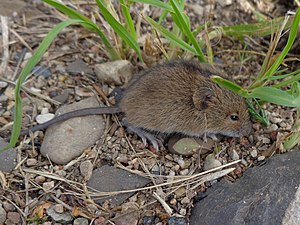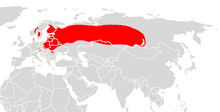Forest birch mouse
| Forest birch mouse | ||||||||||||
|---|---|---|---|---|---|---|---|---|---|---|---|---|

Sicista betulina |
||||||||||||
| Systematics | ||||||||||||
|
||||||||||||
| Scientific name | ||||||||||||
| Sicista betulina | ||||||||||||
| ( Pallas , 1779) |
The forest birch mouse or striped hop mouse ( Sicista betulina ) is the best known species of birch mouse .
External features
The tiny forest birch mouse is even smaller than the harvest mouse . It reaches a head-trunk length of 50 to 72 mm, a tail length of 140 to 150% of the head-trunk length and a weight of 5 to 11 g. The upper side of the body is yellow-gray with blackish dots and an eel line (dark stripe), the underside is light gray.
distribution
The forest birch mouse prefers moist to swampy, covered terrain. Except in moors and wet meadows , it lives in forests. In the mountains you can find them up to 2000 m altitude. It occurs in Fennoscandinavia and Eastern Europe . In Asia it reaches the Yenisei and the Lake Baikal area . In Germany it is found in the Bavarian Forest, in the Allgäu Alps and in flat wooded areas in Schleswig-Holstein. The species was discovered relatively late. For Austria it has been used for parts of the Alpine region since 1967. In 2010 they were discovered in southern Burgenland in Markt Allhau (349 m above sea level). The first evidence from the 3-country Bohemian Forest region dates from 1950.
The similar steppe birch mouse ( Sicista subtilis ), however, occurs as a steppe inhabitant in the area between Hungary and southern Russia.
behavior
Birch mice are active from the beginning of May to October, mainly in the twilight period and at night . The mouse inhabits underground passages that it digs itself. On the ground it moves by hopping, in the branches it is a skilful climber, using its long tail as a climbing aid. Her voice is a high-pitched, low, whistling beep. The mating takes place in the months of May / June. After a gestation period of 25 days, up to six blind young are born in the summer nest, which is in the genist, grass or moss, and they develop only slowly compared to other mice. The nestlings are suckled for five weeks. The birch mouse hibernates for eight months in a self-dug hole in the ground.
food
Forest birch mice eat grass seeds, berries and fruits , but also insects and larvae .
literature
- David Macdonald (Ed.): The Great Encyclopedia of Mammals. Könemann Verlag in the Tandem-Verlag-GmbH, Königswinter 2004, ISBN 3-8331-1006-6 .
- Detlef Schilling, Detlef Singer, Helmut Diller: Mammals. 181 species of Europe (= BLV determination book. Vol. 34). BLV-Verlagsgesellschaft, Munich et al. 1983, ISBN 3-405-12846-3 .
Web links
- Birch mouse in Bavaria
- In search of the birch mouse in Schleswig-Holstein
- Sicista betulina inthe IUCN Red List of Threatened Species 2013.1. Posted by: Meinig, H., Zagorodnyuk, I., Henttonen, H., Zima, J. & Coroiu, I., 2008. Retrieved September 9, 2013.
